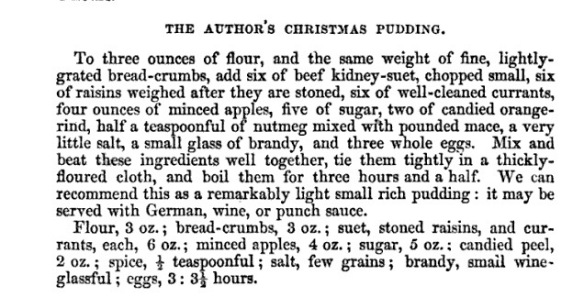
The Christmas plum pudding we know today evolved from that old British food staple, ‘pottage’ – a soupy stew made from grain, vegetables and meat, thickened with breadcrumbs and flavoured with spices, and sometimes, fruit and wine. Plum pottage was a medieval Christmas dish and it was served as a first course, which would have been a hearty start to the meal, one wonders if you would have room for anything else.
Oddly, as with so many little kitchen utensils, the re-useable pudding cloth only became common at the beginning of the 17th century, before that few thought to use fabric to cook a pud. The fashion of encasing the popular baked puddings and pottages in a cloth then took off (particularly as most poor households did not have an oven) and some, like plum pudding were also left to hang after boiling or steaming, to improve the flavour.
As the centuries wore on the meat in plum pottage was replaced by suet, the plums (dried prunes) replaced by a wider variety of dried fruits and nuts, and the alcohol content raised considerably. By the 1830’s the ‘cannonball’ crowned with holly we associate with Christmas had firmly taken hold in our culinary calendar
I include below a recipe for Christmas Pudding in Modern Cookery for Private Families by Eliza Acton (1868 ed) below, but it’s rather late in the day to make this for Christmas so if you wish to buy one, I recommend the superb puddings of Georgie Porgies Puddings https://www.georgieporgiespuddings.co.uk/ which can be bought online.
To steam a pudding, you place it in a cloth in a bowl submerged in simmering water-https://www.bbcgoodfood.com/videos/…/how-steam-pudding
To boil a ball pudding – the pud must be wrapped in calico or very thick muslin (scalded with hot kettle water to remove any chemicals) and submerged in simmering water. The scalded cloth should be floured, then the mixture placed in the middle and the corners of the cloth brought together above it, form the ball and tie it. Boil the pudding according to weight usually about 4 -5 hours but 3 1/2 in the recipe below. Remove it with tongs and allow to hang in a cool place, over a bowl for two days or until the cloth is dry. I like to re-tie it new dry calico to avoid risk of mould and then hang for a month. Re-boil on Christmas day for 1-2 hours.

Eliza Acton – Modern Cookery 1868




